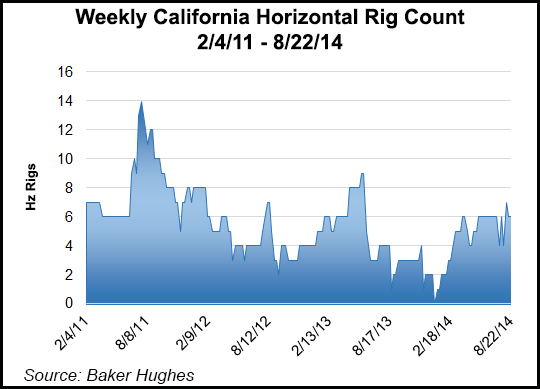E&P | NGI All News Access | NGI The Weekly Gas Market Report
BLM: California Fracking Impacts Overstated
Hydraulic fracturing (fracking) in California, including its associated water use, is relatively benign, according to an independent report commissioned by the U.S. Bureau of Land Management (BLM) that was released Thursday.

Peer-reviewed by the U.S. Geological Survey, the 400-page report was authored by the California Council on Science and Technology (CCST), which chartered a steering committee to guide the report’s development by the Lawrence Berkeley National Laboratory and the Pacific Institute. BLM commissioned the work last year.
The report concludes the level of toxicity of chemicals used in fracking warrants further review under the SB 4 mandate.
A spokesperson for the Western States Petroleum Association (WSPA) said the report’s executive summary “validates the message our industry has been articulating for years: hydraulic fracturing is a fundamentally safe oilfield technique and when applied to California’s unique geologic setting and under California’s strict regulatory paradigm poses no threat to the environment or the public.”
He said WSPA staff, members, and experts are ” keenly interested” in the CCST report’s detailed findings, especially as they may relate to the companion effort required by SB 4.
In conjunction with the study’s release, BLM California Director Jim Kenna signed an internal agency document directing BLM field offices throughout California to request more detailed information from oil/gas operators when processing drilling permit applications, particularly those planning to use fracking.
Among the report’s 11 main conclusions are:
“Responsible decision-making requires good science to balance economic potential with environmental concerns,” said CCST Executive Director Susan Hackwood. “This report provides the most objective, up-to-date, peer-reviewed assessment available to inform thoughtful policy making in California while also characterizing issues that require further study.”
Titled “Advanced Well Stimulation Technologies in California,” the report cited the U.S. Energy Information Agency as earlier indicating that there may be a “new class” of very deep unconventional resources in source rocks themselves. And this is supposedly particularly true for the Monterey Shale, the report said.
Jane C.S. Long, chair of the CCST steering committee, said California citizens should know that “scientists conducting this study brought a wide variety of expertise, extensive experience and open minds to this assessment.”
The report concluded that there have been “no publicly reported instances” of potable water contamination from subsurface releases, and well stimulation technologies, “as currently practiced in California,” have not caused increased seismic activity.
A similar study is in progress by the state as mandated by California’s well stimulation law (SB 4), which was passed last year. Under development by the California Resources Agency, that report won’t be completed until next year.
© 2024 Natural Gas Intelligence. All rights reserved.
ISSN © 2577-9877 | ISSN © 1532-1266 | ISSN © 2158-8023 |
